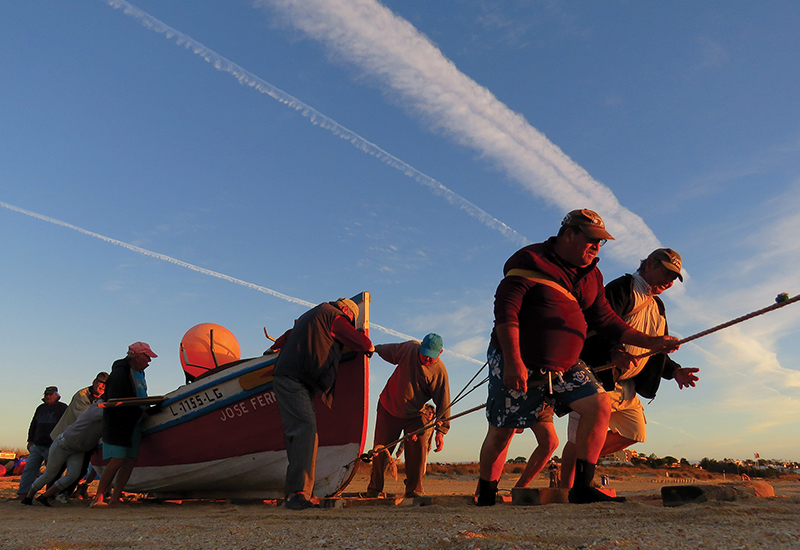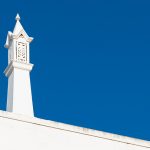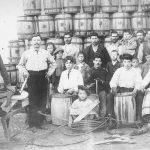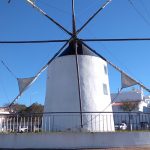Anyone who has strolled on Meia Praia beach in Lagos very early in the morning may have seen a curious sight. A red and white wooden boat out in the water and a group of people in two lines laboriously hauling in a large net. They will have witnessed something unique – the ancient art of Xávega in action.
And what exactly is Xávega? It is a traditional fishing technique that involves trawling and hauling nets back to land. The gear is launched into the sea with the support of a vessel, leaving one cable on land and returning with the other cable.
Seine fishing ashore on sandy beaches is one of the most basic forms of fishing. Its origin dates to classical civilisations of the Mediterranean Sea, who used small boats and manual hauling nets. Later, during the Muslim occupation of the Iberian Peninsula, this type of net used in coastal sea fishing was known as Xábaka (the Arabic word for ‘net’) and expanded throughout Spanish Andalusia and the Algarve. On Meia Praia beach in Lagos it has specific historical and socio-economic relevance. Something that may be under threat if not actively protected.
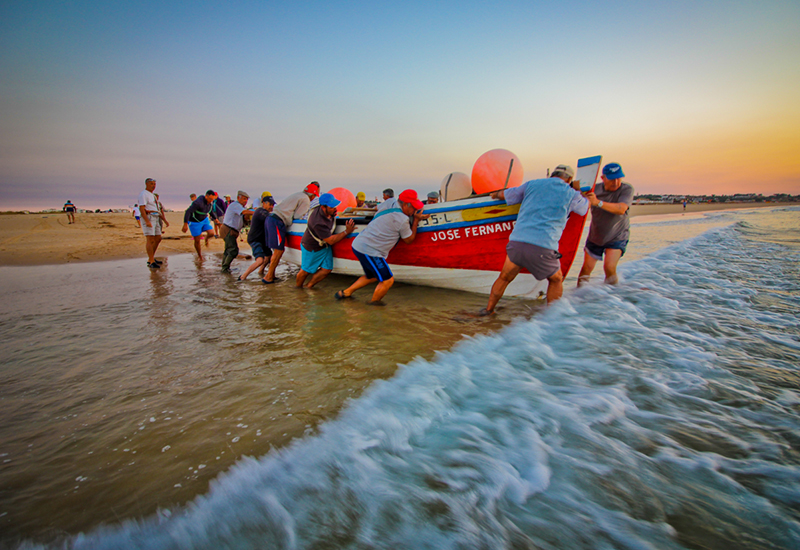
I put on my investigative cap and ventured out. The first port of call was an exhibition of Xávega at the Casa Manuel Teixeira Gomes in Portimão. The acclaimed photographer Pedro Noel da Luz exhibited an evocative set of images of fishermen engaged in net fishing on Meia Praia taken one morning in August 2017. I enjoyed the exhibition. He also put me in touch with José Zé ‘Bala’ Santos, the person who is vital to the practice of Xávega in the Algarve.
I meet José Santos at the petrol station in Meia Praia, the place where he has his customary morning coffee. Although looking rather drawn because of his recent heart operation, he assures me he is now ready for action again.
Seventy-three-year-old José was born practically on the beach in the fishing village Bairro 1.º de Maio on Meia Praia, when there were little more than tin shacks. After the 1974 Revolution, people from his village and the neighbouring village, Bairro de 25 de Abril, were helped to build their own brick houses as part of a national housing programme. He tells me he comes from a family of fishermen and decided to dedicate his life to the sea early on. As a young boy, he liked going to the beach and watching the older men mending their nets. “It was from the old masters that I learnt everything about fishing and the sea,” he says.
I was curious to know how he gained the nickname Zé ‘Bala’ (bullet). He chuckles: “When I was a young boy playing on the beach, some soldiers were doing manoeuvres. I picked up some bullet cases and showed them to my friends. The nickname ‘Bala’ has stuck with me ever since.”
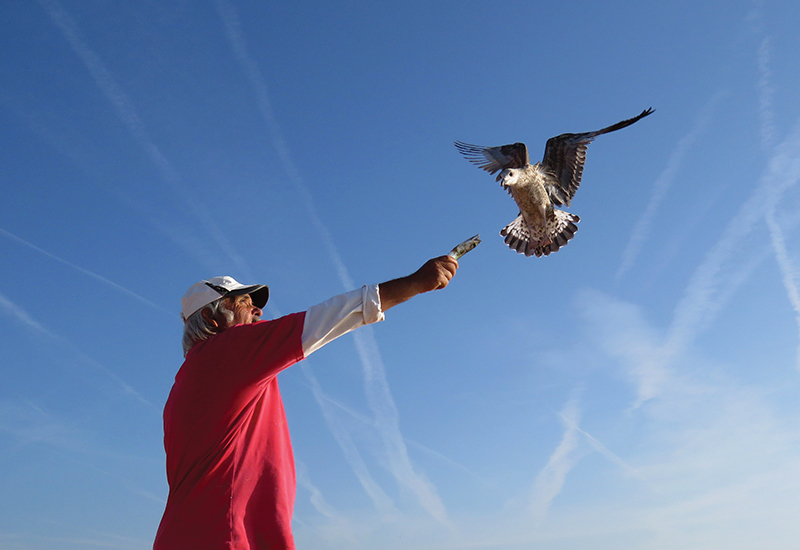
At the age of 15, he received his boat licence and, since then, has had experience with many different forms of fishing. “Life was tough at this time,” he remembers. “Everyone worked either at sea or on the land and earned very little.”
After returning to the Algarve in the mid-1970s, having served in Guinea during the colonial war, he realised that Xávega had almost disappeared in the Algarve. The older ones had left, and the younger ones weren’t interested.
He made a decision that profoundly affected this kind of fishing on Meia Praia. With the money he had earned working in a canning factory and later as a security guard in a hotel, he bought two licences for Xávega in Salema in 1983. “I got them for 70 contos, which was a lot of money then. And it was cash, not a bank loan,” he remarks. A boat was part of the deal but was wholly inadequate. He sold the second licence and acquired a smaller, lighter boat, José Fernando in Sagres, that he still uses. But he laments: “It already had 50 years of service when I bought it and requires much maintenance. If only I could afford a new boat …”
I want to piece together what happens when it’s time to go Xávega fishing on the beach. Using all the knowledge he has gained over the years, Mestre Zé calculates the direction of the wind, tide, currents and stars, and knows the optimum time to go fishing. The evening before, he calls on people to help. And the message spreads through the grapevine. Neighbours, people from the surrounding countryside and the city are all welcome, including any tourists or visitors who want to have a go.
While the city still sleeps, the group of men and women gather on the beach at 6.30 am. The most experienced form the so-called companha (company). They are able to perform specific tasks such as mending nets, boarding the boat and guiding the hauling. The ajudantes (helpers) are anyone who turns up to assist that morning and learn from the ‘companions’. Two companions fetch the boat engine in a wheelbarrow from José’s house, 500m away.
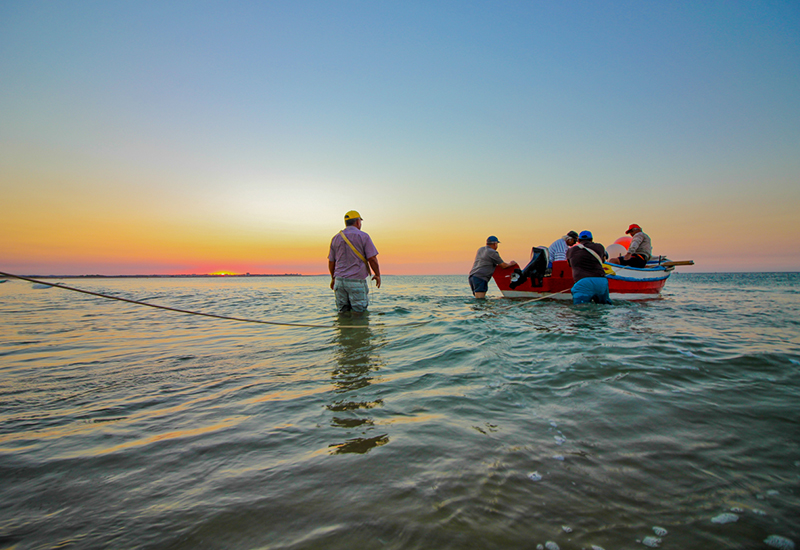
“The first task is to launch the boat into the sea with the help of wooden sleepers (parais), which have been greased with lard to make it easier. It’s hard work with some pulling and others pushing,” Jose explains. “Two or three men get into the boat with me, and the rest stay on the beach.”
The net has two sleeves (asas) of 300m each and a bag where the fish are caught. Two cables (calões) hold the sleeves together. One of the sleeves is kept in the boat, and the other is tied to anchors on the land. The fishermen throw the net overboard but keep the cable in the boat. Then, having completed a large semicircle, the boat returns to shore.
José tells me he has a licence to drop the net up to three kilometres away but only goes as far as 1000m as this is the limit of the manual strength of the people hauling the cables (calas) on the beach.
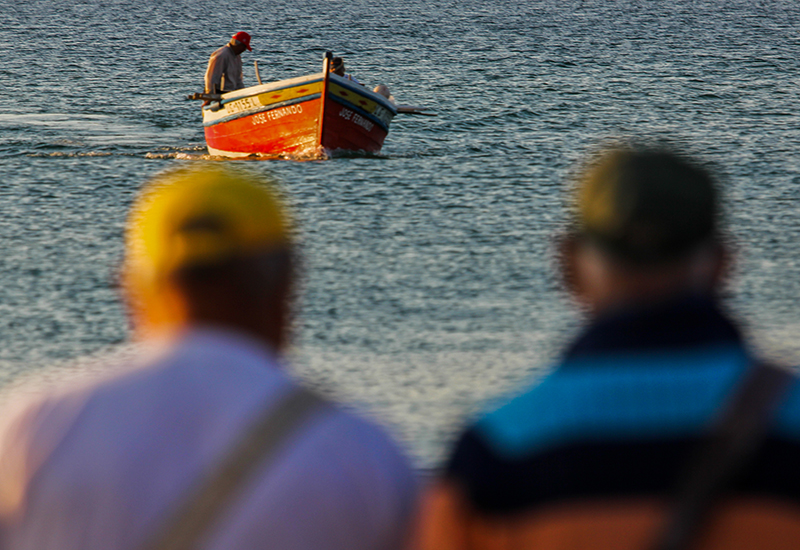
While waiting for the boat to return, the helpers enjoy their shared mata-bicho (breakfast), washed down with liberal doses of medronho, and share their stories. It’s a real community affair. Plastic bottles are filled with salt water, essential to clean the fish and retain flavour – something I hadn’t realised.
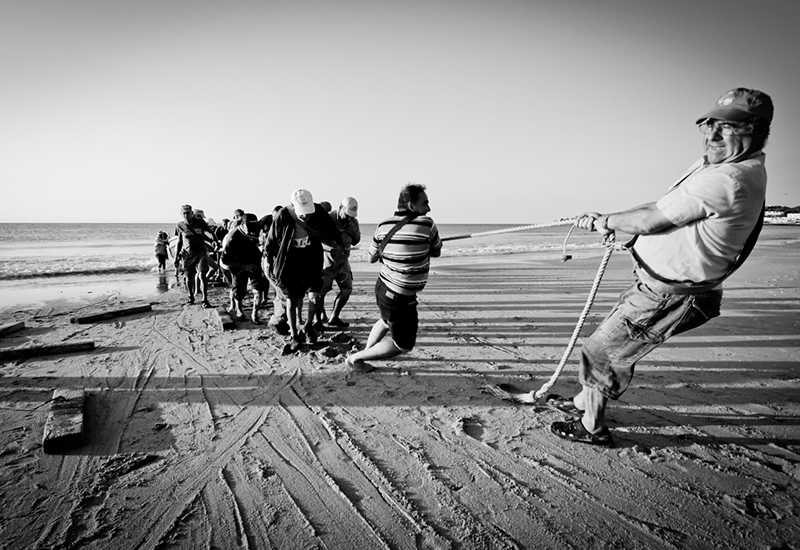
The real hard work starts when the boat returns after about an hour. The net can be seen at the edge of the surf with, hopefully, a multitude of silvery fish splashing around. “We throw a handful of sand into the net. It scares the larger, bolder fish so they won’t escape,” José explains.
A minimum of 16 people, divided into two groups, are required to haul in the two cables on each side of the net. Most wear a thick belt around the shoulders to make the task easier. Exchanges of jokes and sayings punctuate the rhythm of the movements, all delivered in the Algarvian dialect!
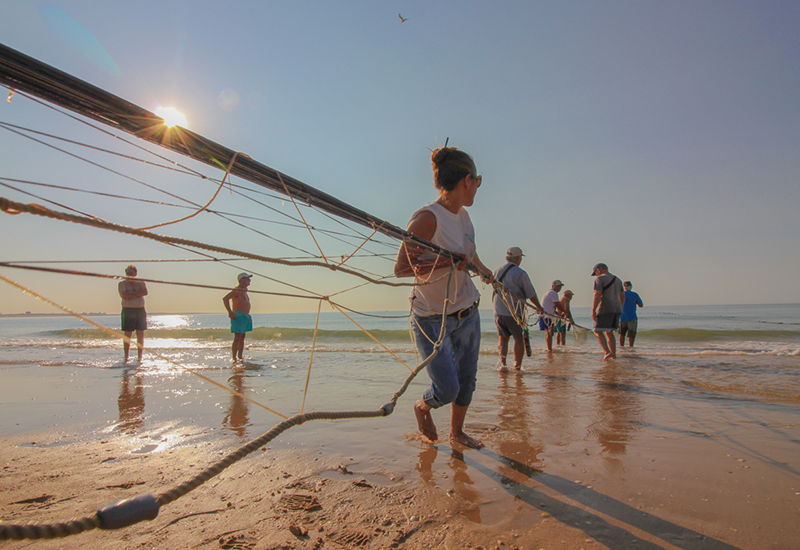
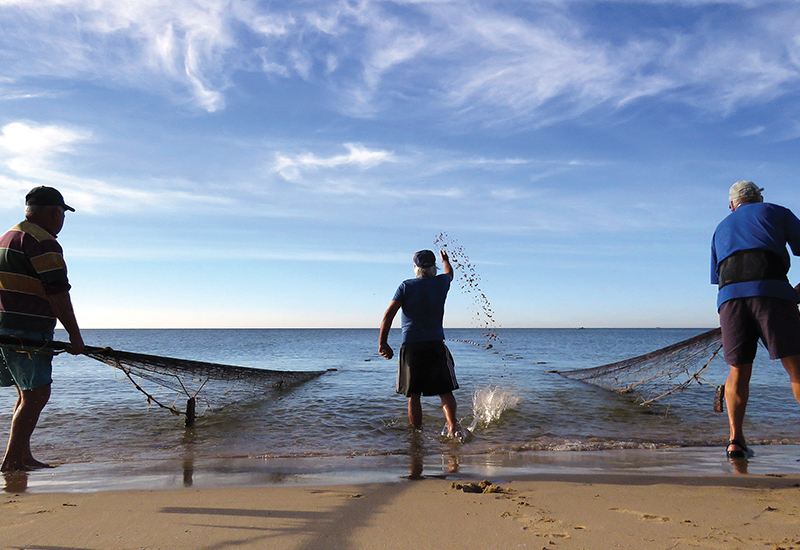
Once the bag is securely on land, it’s cut open to reveal the day’s catch. Has the Mestre been right in his calculations this time? When the sea is generous, there is plenty to go around. The most common fish are mackerel, sardines, sea bream, red gurnard, mullets and pandora. If lucky, there might be a variety of sea bass, rays, turbot squid, octopus, etc. The haul is divided into species in separate boxes. The most valuable fish is auctioned on the spot. I imagine there can hardly be any fresher fish than this. The money gained goes towards fuel and maintenance of the boat.
All helpers receive their quinhão, a share of the catch they take home. The rest is taken to the official auction at the fishermen’s harbour in Lagos. But there is no time to rest yet. The boat must be hauled in, being much heavier now and requiring extra strength.
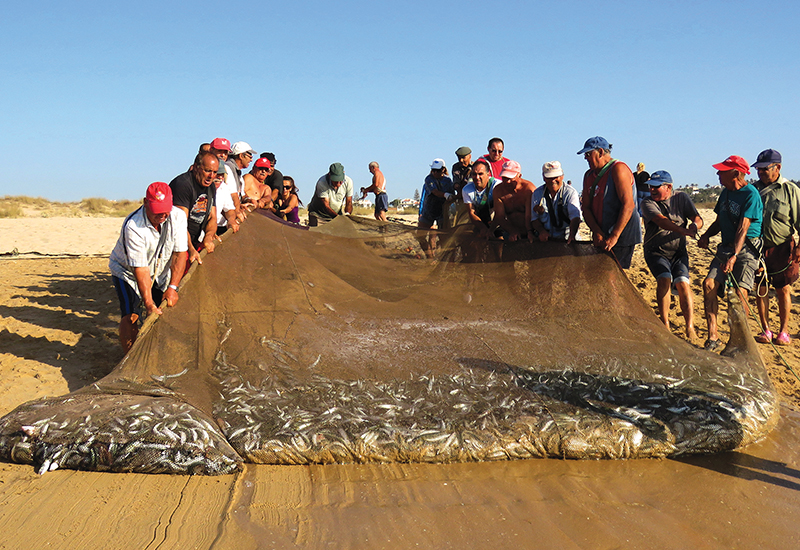
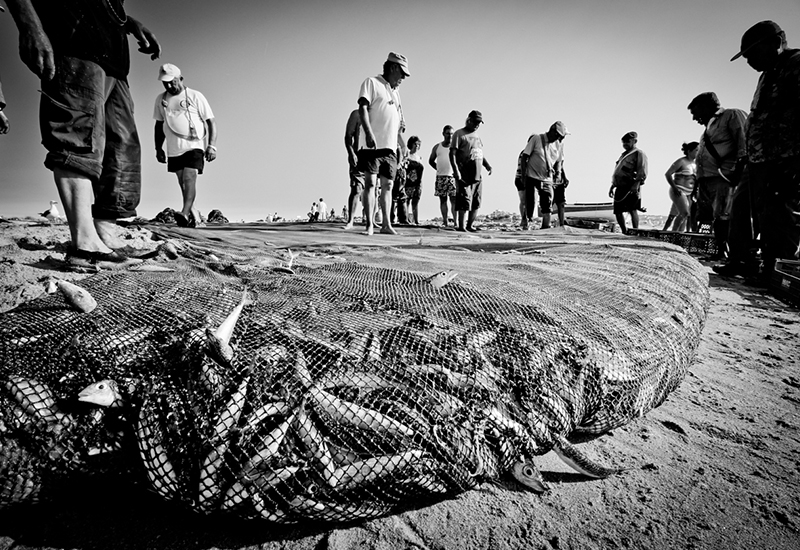
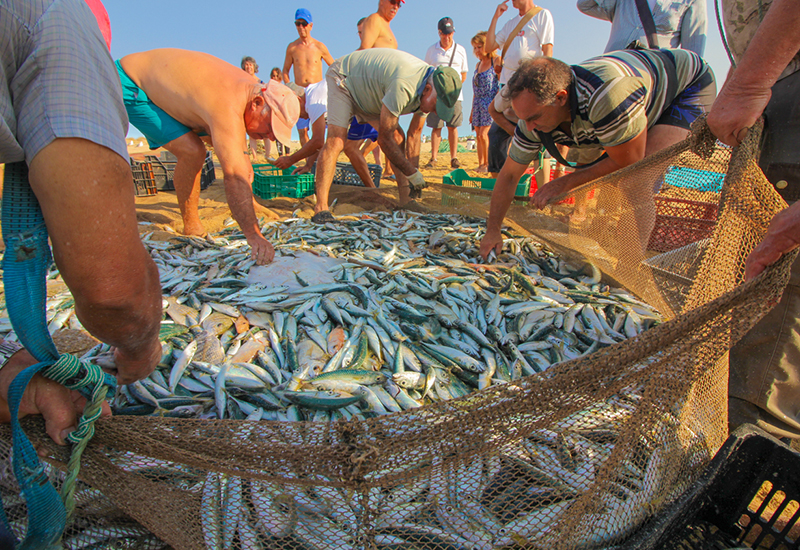
The net is carefully cleaned, mended where necessary and sewn up to close the sack. It is stored inside the boat under canvas to keep it moist in readiness for the next fishing trip. From May to October, Xávega is done about twice a week and in wintertime when the weather allows.
Luckily for me, there is an excellent documentary photo exhibition of Xávega at Lagos Cultural Centre, still on until the end of December. The photographer, Dina Salvador, agreed to talk to me and share her profound interest in this form of fishing. She values the collaborative work and the fellowship among the participants. Being a marine biologist, she also knows the environmental impact of fishing. Xávega is done in the north of the country, too, but with tractors. This is a problem as the machines haul in the net very fast, vacuuming up everything in its way, including small fish that are discarded,” she explains.
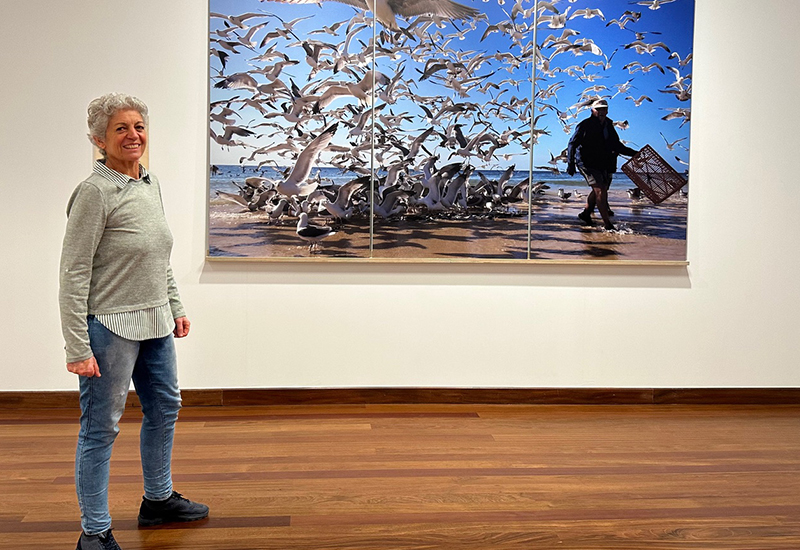
She compares it with the practice on Meia Praia, where it’s done manually and with nets that have larger openings to allow smaller fish to escape. “It’s the only place in Portugal where it’s done this way. It benefits the local community as some of the fish are distributed to families that aren’t able to participate. It is also an attraction for tourists. It’s something that we need to preserve.”
Lagos City Council agrees. In December 2019, it commissioned a seven-month anthropological study of Xávega on Meia Praia, coordinated by Francisco Castelo, responsible for the archives at Fototeca Municipal de Lagos, and directed by Susana Filipa Santos from Coimbra University. Innumerable interviews were conducted, including with José ‘Zé Bala’ Santos. The findings, including some of Dina’s photos, were exhibited at the Cultural Centre in 2020. Because of its cultural and historical value, the council requested that the artisanal practice of the Art of Xávega be classified as an Intangible Cultural Heritage.
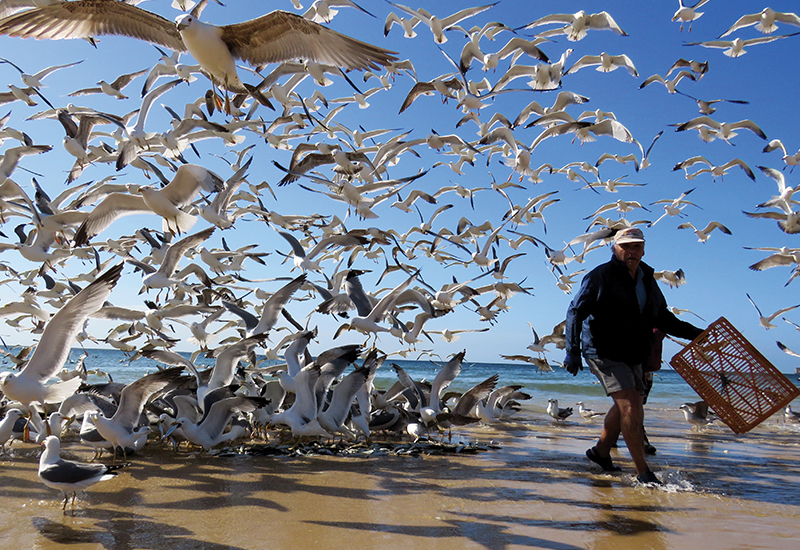
The process is lengthy and has not yet been concluded. So, what is the future of Xávega on Meia Praia?
Many factors put this kind of fishing at risk. The licence holder must sell fish at the local auction for 8000€ annually. No sales mean no licence. José Santos has been granted some exceptions because of his ill health, but the law still prevails. He is insistent that he wants to continue with Xávega to the very end as this is so much part of his life, but what happens then?
In a communique, the Lagos Council said they still maintain their active support of Xávega fishing. They have continued to promote it to the public and resolved problems between José Santos and the maritime authorities. They acknowledge the issues of his health and advancing age, along with the lack of interest of other fishermen to pursue fishing in the current, unprofitable way.
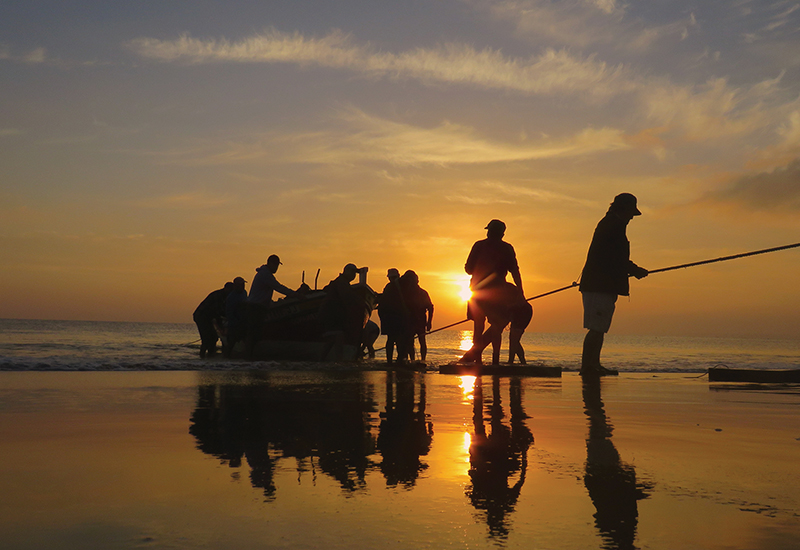
They conclude: “Maintaining this fishing art presents challenges for which the municipality has sought to bring together partners, synergies and dynamics that enable its continuity. Even though it is a private economic activity in which the local authority can hardly intervene, recognising the importance of its cultural component leads us to support it in whatever way we can.”
I sincerely hope there is a way forward. In the meantime, let’s take our hats off to Mestre José Zé Bala Santos for his heroic efforts over the years.
Main photo © Dina Salvador
The documentary photo exhibition of The Art of Xávega Fishing on Meia Praia by Dina Salvador can be viewed at the Lagos Cultural Centre from Tuesday to Saturday, 10 am to 6 pm. It is open until the 30th of December 2023.
